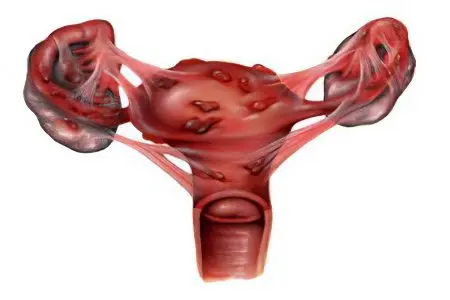Contents
What is dysmenorrhea in women?
Dysmenorrhea – These are violations of the menstrual cycle, accompanied by painful sensations. Although modern neurophysiologists use this term to designate a wider range of concepts, which includes disorders of the endocrine, neurovegetative and mental systems. At the same time, the leading symptom of these disorders is expressed in the pain syndrome on the eve of menstruation, which is associated with the accumulation of degradation products of arachidonic acid in the endometrium.
According to statistics, dysmenorrhea is widespread among the female population and the incidence ranges from 43% to 90%. At the same time, 45% of women suffer severely from dysmenorrhea, 35% experience moderate symptoms, and 20% tolerate menstrual irregularities easily. In addition, scientists note that the severity directly depends on the working conditions, social status and character of the woman.
In medicine, in addition to the term “dysmenorrhea”, you can find the concept of “algodysmenorrhea” or “algomenorrhea”, which mean the same thing.
Symptoms of dysmenorrhea

The leading symptom of the disease is painful sensations of varying intensity observed during menstruation.
However, dysmenorrhea may be accompanied by other symptoms, including:
Headache.
Pain in the lower abdomen, most often sensations are sharp, with a predominance in the first days of the onset of menstruation. Often there is irradiation of pain in the back, legs, lumbar.
Fainting, sleep disturbances.
General weakness, lack of appetite.
Feeling of dryness in the mouth, or, conversely, increased salivation.
Complaints about the feeling of “cotton legs”.
Diarrhea, nausea, sometimes accompanied by vomiting. Feeling of bloating, distension of the abdomen.
Increased body temperature, sometimes up to 38 ° C.
Decreased performance and memory.
In some cases (approximately 15%), women are completely unable to work at the time of the onset of menstruation. This is due to the high severity of symptoms.
These symptoms refer to manifestations of primary dysmenorrhea, one that does not occur against the background of a concomitant disease. The symptoms of secondary dysmenorrhea will depend on what is the underlying cause of the disease.
Causes of dysmenorrhea
Among the reasons leading to the development of the disease, the following are noted:
Malformations associated with impaired development of the internal genital organs. Such disorders are congenital and are associated with the influence of a number of factors, including: chemical, physical and biological. At the same time, a closed additional vagina can affect the violation of the outflow of menstrual blood. What is expressed in its doubling, and often the second vagina ends blindly. This leads to the fact that blood is retained in it, resulting in pulling and aching pains. Another anomaly in the development of the genital organs is a closed accessory horn of the uterus. With its incorrect formation, the main organ splits into two additional cavities. The accumulation of blood in them leads to compression of the nerve endings, inflammation of the ovaries, fallopian tubes. The pains are so severe that a woman can lose consciousness.
Metabolic disorders and the formation of prostaglandins, which are responsible for many metabolic processes in the body. Among these processes are the contraction of the muscle layer and the occurrence of spasms, which are expressed in the appearance of painful sensations. Disturbances in the production of prostaglandins can be due to both congenital characteristics and be acquired during life.
Disturbances in the production of hormones, especially the imbalance between estrogen (its excess) and progesterone (its deficiency). This leads to the formation of a persistent muscle spasm of the uterus, an increase in its tone, which manifests itself in pain sensations of varying intensity. In addition, pain may be accompanied by cycle disorders. Often, such an imbalance is eliminated after a woman gives birth to a child.
Growth of the endometrium – endometriosis. The cause of the development of dysmenorrhea is endometriosis in about 9% of cases, and can lead to the loss of the ability to reproduce. In addition to pain, a woman is concerned about cycle disorders, spotting in the period between menstruation.
Tumors of the ovaries.
Uterine fibroids, which is a tumor, but benign. At the same time, menstruation is long, profuse, painful, they contain blood clots. As the disease progresses, the amount of blood lost also increases, leading to anemia. The pains are cramping, often there is a feeling of heaviness in the lower abdomen.
Wearing an intrauterine device, which can cause dysmenorrhea and lead to menstrual irregularities in the direction of increased bleeding, the appearance of intermenstrual bleeding.
Adhesions in the pelvis, which leads to chronic pain, cycle disorders and, sometimes, reproductive function. Often there is amenorrhea, characterized by a prolonged absence of menstruation.
Varicose veins of the pelvic organs. This cause often leads to pelvic pain that cannot be diagnosed.
Infectious diseases, for example, gonorrhea, syphilis, genital tuberculosis.
Hyperanteflexia of the uterus or its inflection. At the same time, there are pains during menstruation, during intercourse, abundant discharge, childbearing function may be impaired.
Genital infantilism, characterized by delayed sexual development.
Genital trauma.
These are the most common causes leading to the development of the disease.
Types of dysmenorrhea

In the vast majority of cases, dysmenorrhea is acquired, that is, a pathology that is formed as a result of violations in the work of the genital organs. These disorders are caused by the presence of a particular disease. However, dysmenorrhea can occur at a young age without any underlying pathology. Therefore, there are two types of disease: primary and secondary.
Primary dysmenorrhea
Speaking of primary dysmenorrhea, you can come across the term idiopathic dysmenorrhea. At the same time, there are no diseases of the genital organs. It can occur both after primary menstruation and after several years of regular cycles. At the same time, at the initial stages, the pains are not too pronounced and do not bother the woman too much: they are short-term, aching, and do not significantly affect the ability to work. However, after several years, the pains intensify, they can begin to bother a day before the start of menstruation, and their duration reaches several days. At the same time, it radiates to the bladder, rectum, fallopian tubes, ovaries, etc.
There are two theories, each of which tries to explain the cause of idiopathic dysmenorrhea. It is possible that disorders in the production of prostaglandides and thromboxanes lead to the development of pathology. The second theory is that the disease develops against the background of hormonal disorders.
In addition, doctors have noticed a trend that patients who complain of pain during menstruation have such diseases that are not related to the genital area, such as mitral valve prolapse, myopia, vegetative dystonia, scoliosis and flat feet.
Secondary dysmenorrhea
Secondary pathology is the result of the fact that a woman has a variety of organic diseases. There can be many reasons, the main ones were listed above. Painful sensations are caused by a violation of the blood supply to the uterus, the occurrence of a persistent spasm of its muscles, stretching of its walls, etc.
Treatment of dysmenorrhea
Treatment of pathology in the first place is reduced to the relief of pain, disturbing during menstruation. If any disease has been identified, then it is necessary to carry out etiological therapy.
The following treatments are practiced:
Hormonal correction, which primarily depends on the severity of the pathology. If the disease is mild, then painkillers are not prescribed. When dysmenorrhea is of moderate severity, then the woman is shown taking painkillers, which do an excellent job. With severe dysmenorrhea, analgesics, as a rule, do not help and correction of the hormonal background is required. For this, such means are used as: duphaston and gestagen (it is possible to prescribe with moderate and mild severity of the disease), lindinet 20 (used for severe dysmenorrhea, the drug belongs to the group of multi-phase oral contraceptives), buserelin (used for the treatment of dysmenorrhea caused by genital endometriosis and extragenital).
Relief of pain syndrome with non-steroidal anti-inflammatory drugs. Moreover, it is in the primary form of the disease that NSAIDs are a necessity. The most popular drugs are ibuprofen, naproxen, indomethacin, ketoprofen, diclofenac, paracetamol, rofecoxib. If the disease is of moderate severity, then you can take one tablet up to 2 times a day. With severe pain syndrome, the dose can be increased to 3 tablets per day throughout the cycle.
Physiotherapy treatment. Among the variety of methods, the most popular for the treatment of moderate and severe diseases deserved: coniferous and nitrogen baths, ultratonotherapy, galvanization of the brain, heliotherapy, electrical stimulation of the cervix, UV radiation in erythemal doses. However, it is worth familiarizing yourself with the contraindications to the implementation of therapeutic techniques, which are often found in women with dysmenorrhea. Among them: uterine fibroids, endometriosis, cancer, inflammation of the uterus and ovaries in the acute phase, polycystic ovary syndrome, CNS pathology.
In addition, a woman should not ignore non-drug methods of getting rid of the disease. Among them: the implementation of a complex of physiotherapy exercises that contribute to the normalization of blood circulation in the small pelvis, compliance with the work regimen with enough time for rest and sleep, giving up bad habits, avoiding overwork, stress, psycho-emotional stress. It is also important to regulate the diet with the inclusion of foods rich in vitamins C, E, magnesium and Omega-3 unsaturated fatty acids.
Prevention of dysmenorrhea

No less important are preventive measures aimed at preventing the development of the disease:
First of all, this is a regular passage of a gynecological examination. It is especially important that the first visit to the gynecologist is no later than 16 years, provided there are no complaints. After the onset of sexual activity, examinations should be regular, that is, at least once a year. The period of pregnancy should be completely under the supervision of a gynecologist.
Secondly, it is necessary to promptly treat all inflammatory processes occurring in the pelvic organs. This will avoid menstrual irregularities and severe pain.
Thirdly, it is desirable to abandon the use of intrauterine devices, especially until the moment the first child is born or in the presence of certain diseases.
It is worth avoiding abortions, since mechanical damage to the uterine mucosa can lead to serious violations of the menstrual cycle and not only.
It is also advisable to take preventive measures because dysmenorrhea can lead to serious complications. Among them: the development of psychosis against the background of constant intractable pain, loss of working capacity, infertility and the development of a chronic disease in the secondary form of dysmenorrhea.









